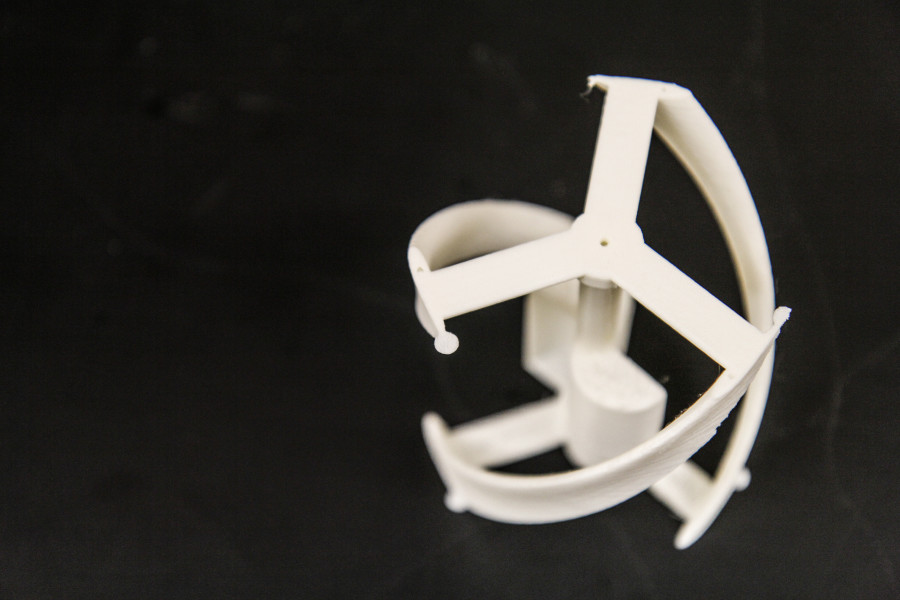Whitman Students Build Wind Turbine
Photo by Marra Clay.
November 19, 2015
By the spring of 2016, some of Whitman’s physics students will have finished building a vertical axis wind turbine. The wind turbine, which will be located between Penrose Library and Harper Joy Theater, will be the first student-constructed wind turbine on a college campus. Because of the relatively low wind speeds on campus, the wind turbine will not produce much power; however, it will hopefully educate the community about sustainability.
No companies produce wind turbines that can generate power with the low winds speeds normally seen on Whitman’s campus. This necessitated that Whitman students design and build the wind turbine themselves to fit the campus environment.
“There is no company that has a wind turbine that will produce electricity at the rate at which we get wind. Right in the middle of our campus, there’s not a ton of wind. So then we explored the idea of a student-built one, which we could tailor to the amount of wind we have,” Junior Danielle Hupper said.
The first design challenge that students faced was finding and testing a generator that could produce power even with small amounts of wind.
“We have tested the generator we [built] and a positive sign we have found out through our tests is that it can generate a lot of power while turning really slowly, which is great because we don’t have very high wind speeds here on campus,” Junior Physics Major Collin Faunt said.

In addition to working out how to generate power, students had to find an ideal location for the wind turbine.
“We did some testing for where the best places on campus would be to put it–where [there’s] the highest wind–the campus doesn’t have very [high] wind in general, but there’s a little corridor between the library and Harper Joy Theater where there’s a wind tunnel effect that will help get higher speeds,” Senior Physics Major Peter French said.
Currently, these students are testing different propeller designs and working on some final electrical and physical elements.
“From here, we’re going to find a good propeller design and order the parts for the base and the structure, so now we just need to get the electrical and structural components to put it in place,” Faunt said.
While progress has been smooth, it has been slow due to the fact that the students have many other engagements. Nonetheless, the students should have no trouble completing the wind turbine by next spring.
“It’s moving along at a pace that you might expect for something that is an add-on for some of the students, but the project is still on schedule to finish in the spring sometime,” said Professor of Physics Kurt Hoffman, the advisor for the project.
Once done, the wind turbine will only produce a small amount of power–the group’s goal is for the turbine to generate enough energy to charge a single cell phone at a time. As such, the turbine would primarily serve as an instructional resource.
“The emphasis would be on education and demonstration rather than on the mitigated emissions that the wind turbine would have. [Adjunct Professor of Environmental Studies and Sports Studies] Amy Molitor was talking about making an [Environmental Impact Statement] for the wind turbine in one of her classes. We were also talking about how there is going to be a plexiglass base so that you can look inside the wind turbine,” said Hupper.
While this project has modest goals, Professor Hoffman and some physics majors are contemplating exploring more ambitious sustainability projects in the future.
“The real source of energy here that is most reliable is the flowing streams nearby. I think that could be a generator that could actually generate quite a bit of power where one could actually light lights, or have something more sophisticated in terms of its usage,” said Professor Hoffman.
College Creek, which runs from the area by Maxey Hall to the area by Anderson Residence Hall, would likely be the sight of such a project. However, for now students are focused on the turbine, and those affiliated with the project would love more volunteers.
“Anyone can get involved. You don’t have to be a physics, math, science anything. Talk to Professor Hoffman or [one of] us,” said French.







Andrew Dawes • Jan 6, 2016 at 7:07 pm
This is a very cool project and could be very useful approach to micropower considering most turbines are designed for a different environment. The article should mention that you’re using 3d printed prototypes to test your designs, also a very nice use of cutting edge technology. Are there any public resources available for contribution or participation? If not, I’d suggest github or thingiverse. Both can generate (pun intended!) community participation quite quickly.
Gene Spangrude • Dec 3, 2015 at 6:04 pm
Interesting comment made in article about Hydropower (from flowing streams) and its reliability and generating potential……